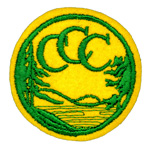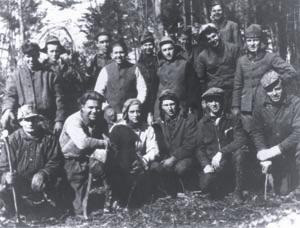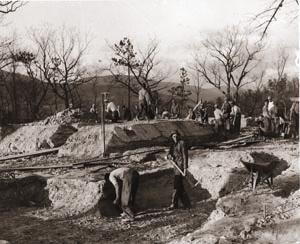|
|
|
|
| |
|

April 14, 2003 -
December 6, 2003
"C.C. CAMP IS A SWELL PLACE FOR A BOY TO LEARN."
Recording Our History: Writers and Artists
Art for the People
For Teachers
Resources |
"C.C. CAMP IS A SWELL PLACE FOR A BOY TO LEARN."
|
| In March 1933 the U.S. Congress established the Civilian Conservation
Corps as a relief program for unmarried young men between the ages of
18 and 25. Within three months, 250,000 men had enrolled. Nicknamed
the "Tree Army," the CCC planted trees to combat soil erosion and
maintained national forests; eliminated stream pollution; created
fish, game, and bird sanctuaries; and conserved coal, petroleum,
shale, gas, sodium, and helium deposits. |
 |
|
CCC patch, Courtesy of Pocahontas State Park |
About 2 million young men took part nationwide during the decade. By
the program's end in 1942, more than 100,000 CCC men in Virginia had built 986 bridges, planted
more than 15 million trees, strung more than two thousand miles of
telephone line, and stocked rivers and streams with more than 1
million fish.
|
 |
The nation's first camp, Camp Roosevelt, opened at Luray, Virginia,
near Massanutten Mountain in the George Washington National Forest in
May 1933. The Forest Service (in the U.S. Department of Agriculture)
and the Park Service (in the U.S. Department of the Interior) used CCC
workers all over the commonwealth on such projects as the Skyline
Drive and Colonial Parkway as well as erosion prevention and
reforestation schemes. |
|
CCC workers building the Great Lodge
at Douthat State Park. Library of Virginia |
The CCC also built cabins and recreational
facilities in six state parks-Douthat, Fairy Stone, Hungry Mother,
Seashore (now First Landing), Staunton River, and Westmoreland-that
opened in June 1936. Camps typically consisted of barracks, mess hall,
motor pool, infirmary, headquarters, officers and staff facilities,
and usually a recreational hall and classroom buildings. |
 |
|
CCC workers building the Great Lodge
at Douthat State Park. Library of Virginia |
Operated by the army but overseen by the War, Labor, Agriculture, and Interior
departments, the CCC enrolled jobless men in work camps for about $30
per month, $25 of which was sent to needy dependents.
Many of the original facilities in Virginia's state parks and natural
areas were built by the CCC and are still used today. As a testament
to the enduring legacy of FDR's "Tree Army," the National Sporting
Goods Association's Sports Foundation Inc. gave Virginia its state
park gold medal in 2001. |
| |
|
|